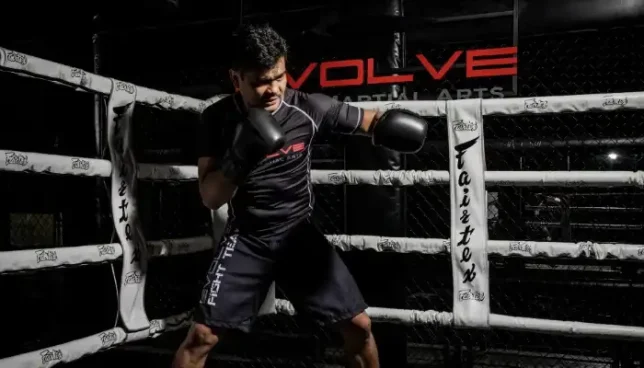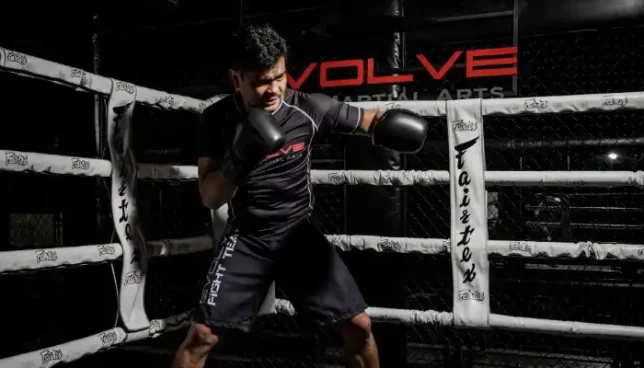Boxing is known as the sweet science, the noble art—a test of physical and mental strength. It’s an ancient sport, with stories about its beginnings lost to the ages. Sumerians and Egyptians are believed to have fought with fists. Ancient Greece made it a part of the Olympics in 688 BC and today we have greats such as Muhammad Ali and Joe Frazier to show for it.
But you don’t have to be an aspiring champion — or even want to be one — to box. Today, we’re talking about why boxing is an incredible fitness activity and how you can start.

A Legacy of Champions: A Brief History of Boxing
Uncertainty clouds the history of boxing due to the scarcity of written records, even those that have survived. The first recorded evidence comes from ancient Sumeria and Egypt, which suggests they had a liking for fistfighting.
Greece gave boxing (pugilism) structure when it entered the ring (literally) in 688 BC’s Olympic Games. Centuries later came bare-knuckle brawls that eventually became gloved contests during the 19th century English establishment of the Marquess of Queensberry Rules, which also paved the way for boxing safety measures still used today.
Why Lace Up The Gloves? The Importance of Boxing
What sets boxing apart is how it benefits both body and mind:
- Cardiovascular health: You’ll burn calories like nobody’s business while also strengthening your heart. This happens because all that moving around, coupled with intense bursts, pushes up blood circulation in ways that improve overall wellness.
- Strength & Power: Throwing punches requires engagement from various muscles within your upper body, thereby building strength as well as stability around core regions, while footwork drills help tone legs while enhancing agility skills too!
- Coordination & Reflexes: To not get hit or land blows on opponents quickly enough, eye-hand coordination must be sharp. Besides, once attacked, there’s a need for a quick reaction, which further enhances reflex development.
- Mental Toughness: Boxing stretches one to their limits both physically and mentally; it instills discipline, focus, and the ability to succeed under pressure.
But beyond these physical aspects, boxing can also have an amazing impact on people’s lives by empowering them with self-confidence through teaching self-defense mechanisms, while also acting as a stress reliever!
From Footwork to Fury: Getting Started with Boxing
Now that you’re pumped up (not literally) about stepping into that ring someday soon, here are some basics:
- Mastering the Fundamentals: You’ll need a strong foundation if you plan on being successful in this sport, which means having things like:
- Stance: A balanced stance from which one can launch power or respond swiftly when necessary.
- Footwork: This is considered as the language spoken within boxing setups since it allows individuals to move around rings better, control distances, and cut off angles for opponents.
- Punches: They include jab, cross, hook, and uppercut, each having its purpose as well as technique behind them!
- Finding Your Team: To ensure progress without harm, look out for gyms with a good reputation where qualified trainers are available who can work out safe programs according to your fitness levels and desired goals.
- Gear Up!: Here’s what you need before entering that squared circle:
- Boxing gloves: Choose ones weighing the right amount of padding based on your experience level.
- Hand wraps: These protect hands and wrists while supporting them during hits made against hard surfaces such as walls or floors, etc.
- Mouthguard: It’s all about safety here, so don’t forget to protect those pearly whites!
- Proper footwear: Make sure to wear supportive athletic shoes that offer ankle stability, especially if engaging activities require rapid movements like jumping.
Train Like a Champion: Your Boxing Blueprint
Training for boxing is hard work, as it requires one to be dedicated throughout the different stages involved. Below are key aspects of training:
- Cardio Conditioning: This is where every boxer should start their routine; running, skipping, or doing high-intensity interval training (HIIT) will enhance your stamina during intense rounds that may come later.
- Strength Training: By increasing muscle strength, you can punch with more power. The upper body, core, and legs should be the main focus during workout sessions. Use bodyweight exercises, weights, and even resistance bands.
- Skill Development Drills: This is where the magic happens. Practice shadowboxing to refine your technique, work with focus mitts to develop speed and accuracy, and utilize heavy bags to build power.
- Sparring and Partner Work: In a controlled setting, sparring allows you to test your skills against a live opponent. Partner drills, such as pad work, help you improve your technique and timing.
- Rest and Recovery: Don’t skimp on rest! Rest days are essential for the body to rebuild and repair muscles damaged during training. It’s also important to get enough quality sleep each night.
Sharpen Your Mind: The Mental Game of Boxing
Boxing is just as mental as it is physical. Here’s how to sharpen your mental game:
- Focus and Discipline: When training or fighting, cultivate laser-like focus; have the discipline to push through fatigue while sticking to the technique that works best for you.
- Visualization: See yourself succeeding. Visualize landing clean punches, dodging your opponent’s attacks, and emerging victorious.
- Understanding Opponent Styles:
- Know your enemy: Watch them on tape; figure out their strengths and weaknesses—do they hit hard or not so much? Are they slick counterpunchers or just come-forward brawlers? Do they prefer to fight on the range or up close inside?
- Adapt and Overcome: Expect unexpected things to happen during bouts, such as getting caught off guard by an unorthodox punch thrown from strange angles by someone switching stances multiple times mid-combo, etc., so always stay calm under pressure while adjusting accordingly tactically.
- Dealing with Nerves and Fear:
- It’s normal: Everybody fears something, even the greatest of all time. Embrace those pre-fight jitters as a sign that you’re alive and ready to compete hard!
- Positive self-talk: Replace negative thoughts with affirmations. Remind yourself of your training, your skills, and your ability to perform.
- Breathing exercises: Deep, controlled breaths slow your heart rate and calm your mind. Practice breathing techniques before and during the fight.
- Develop a routine: Having a pre-fight ritual helps establish a sense of normalcy and control. This could involve listening to music, visualizing your success, or stretching.
Remember: Boxing is a journey. Setbacks are inevitable, but by working on both the physical and mental aspects of the sport, you’ll be able to develop the resilience needed to overcome any obstacle inside or outside the ring!
Building a Champion’s Body: Nutrition and Diet for Boxers
Just as cars require fuel to run smoothly, our bodies require proper nutrition for optimal performance during boxing matches. Here is what you should know:
- The Power of Food: Eat a diet rich in complex carbohydrates, which provide energy throughout the day, and lean proteins, which are responsible for muscle development. Healthy fats promote recovery after intense exercise. Eat whole grains, fruits, vegetables, lean meats, fish, nuts, etc.
- Pre- and Post-Workout Meals: For sustained energy levels throughout workouts, pre-workout meals should mostly consist of slow-digesting carbohydrates like oatmeal or whole-wheat toast with eggs. On the other hand, post-workout meals should aim to replenish glycogen stores and repair muscle tissue, so they should include a combination of proteins like grilled chicken along with brown rice and veggies.
- Hydration is Key: Staying hydrated helps overall health and performance; therefore, take enough water before, during, and after training sessions.
- Making vs Chopping: In case you want to gain more muscles or lose weight, consult a registered dietitian regarding making a plan that is designed for your individual needs and makes sure you take the necessary nutrients.
Don’t Get Hurt in the Ring: How to Prevent Injury
Boxing may be challenging, but you can prevent injuries with the right safety precautions.
- Warm-Up and Cool-Down: Never undervalue the importance of warming up before exercise to prepare your muscles for work and cooling down afterwards to prevent them from becoming sore.
- Stretching and Flexibility: Including dynamic stretches as well as static ones into your routine regularly will enhance not only flexibility but also range of motion, which in turn leads to better performance while lowering the chances of injury.
- Listen to Your Body: Be able to tell when enough is enough; overtraining is characterized by such signs as chronic tiredness, reduced output, and continuous muscle ache. On this note, one must take rest days to give his/her system adequate time for recovery.
- Safety First: Always put on appropriate protective gear like gloves, hand wraps, and a mouth guard, among others, during training sessions, besides finding an experienced coach who can teach correct techniques, thus minimizing injury risk.
Tracking Your Journey: Getting Better at Boxing
Becoming good at boxing requires dedicating oneself fully and always striving for excellence. The following are tips that will ensure one remains focused on their path:
- Set SMART Goals: Specific Measurable Attainable Relevant Time-bound ones keep individuals motivated towards achieving them while working out moves that could see them improve footwork or punch harder within a certain period, all together increasing endurance levels.
- Track Your Progress: Having a training diary enables people to monitor growth stages and have something they can look back on to celebrate achievements made along the way. This involves jotting down workouts done, such as exercises performed, sets completed per exercise, reps executed for every set, and any other notable thing about one’s performance.
- Seek Guidance: Seek advanced training from well-trained coaches who can create customized programs based on the learner’s abilities and objectives as they advance in skill level.
- Embrace The Challenge: Participating in amateur fights provides an opportunity for self-fulfillment by testing limits while competing against others in the same boat, thereby pushing beyond comfort zones altogether.
Conclusion
Boxing is more than just a physical activity; it is also an expedition towards self-realization that strengthens the mind. It imparts discipline, focus, and the ability to overcome obstacles. So wrap up those tight fists of yours, welcome challenges with open arms, and start transforming through boxing today; it won’t let you down.

